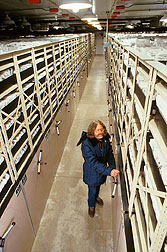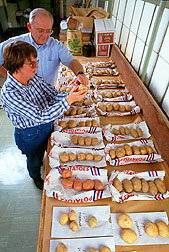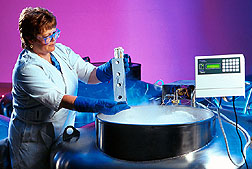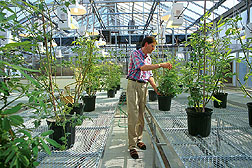At the Root of Civilization: Crop Plants
Busy times are ahead in the new millennium for the Agricultural Research Service, chief scientific arm of the U.S. Department of Agriculture. Its job in the decades ahead will be to help sustain agriculture's ability to meet humanity's growing demand for food, fiber, and other needs. A world population expected to reach 8 to 10 billion individuals by 2050 demands as much.
While America's domestic crop yields have generally increased by 1 percent annually, the new millennium will require that science push the technological envelope much further. In the United States, it's worth noting that the actual task of producing food and fiber now rests with less than 2 percent of our nation's population: farmers. They're also the ones who put into practice what agricultural scientists at ARS, universities, and elsewhere explore in the laboratory.
At the heart of all this, though, are the plants cultivated as our crops. Since humankind's agricultural beginnings thousands of years ago, we've placed on plants the burden of sustaining human populations. In the process, we've removed many plants from their natural habitats and imposed on them a new set of variables under which they're expected to flourish.
With the label of "crop," for example, have come new conditions that concentrate the plants into defined areas, often arranged in uniform rows, and within easier grasp of insect pests or pathogenic organisms that cause disease.
So as we demand more of crop plants, it becomes even more critical to preserve, protect, and improve these leafy green cornerstones of civilization. In this article, you'll read about a few of the many research projects of ARS scientists working to further these three basic goals. As part of a national research priority called Crop Production, Product Value, and Safety, their work is helping ARS be of service to both the agricultural community and its myriad consumers.
20th Century Achievements Set the Stage
For plant physiologist Donald R. Ort and colleagues at ARS' Photosynthesis Research Laboratory (PRL), in Urbana, Illinois, the effort begins with studies on the biochemical machinery by which plants make their food (carbohydrates) and, ultimately, our own.
Nature has endowed plants with the amazing ability to energize their food production machinery with sunlight. They're also quite adept at using other resources from the natural environment around them. Yet, despite the magnificence of nature's design, photosynthesis is often incapable of operating at its full potential, says Ort.
|
|
But modern agriculture suggests the opportunity for improvement.
At Urbana, PRL researchers like Archie R. Portis, Jr., are focusing attention on rubisco. It is a key enzyme in photosynthesis that captures carbon dioxide (CO2), a basic building block of carbohydrates. In keeping with its fundamental importance to life on Earth, says Ort, rubisco is an extraordinarily ancient enzyme that evolved when the planet's atmosphere lacked oxygen.
"Because of this, rubisco never learned how to distinguish CO2from oxygen," he explains. "The outcome of this evolutionary error in today's atmosphere is that, in plants like soybean, rubisco captures oxygen instead of CO2 about 20 percent of the time."
To tackle the problem, Portis, Ort, and colleagues are trying to genetically replace the rubisco of soybean plants with an enzyme from green algae that captures CO2 more quickly. "Soybean plants engineered in this way will be particularly beneficial at the higher atmospheric CO2 concentrations that the next century will usher in," predicts Ort.
The challenge in the next century, he adds, will be to maintain crop productivity in the face of greater temperature extremes, water shortages, and an increasing need to cultivate on marginal land. "Improving the photosynthetic performance of crop plants for these environments holds important promise for U.S. agriculture as it enters the new millennium," he says.
Elsewhere in Illinois—at ARS' National Center for Agricultural Utilization Research (NCAUR) in Peoria—scientists are working to convert starch, protein, oils, and other raw materials gleaned from corn, soybeans, and oilseed crops into value-added products.
NCAUR accomplishments include refining early techniques for mass-producing penicillin, creating the widely used absorbent starch-based material called Super Slurper, and making printing ink from soybean oil.
A more recent achievement from Peoria scientists is Fantesk. It's a composite product prepared from mixtures of cornstarch and oil by a high-temperature, high-pressure cooking process, says chemist and co-inventor George F. Fanta. He and Kenneth Eskins (now deceased) developed and patented the technology, along with colleagues in NCAUR's Plant Polymer and Biomaterials Processing Research Units.
Fantesk—in its liquid, powder, flake, or gel form—offers a slew of promising industrial, agricultural, and consumer uses. Fanta reports the technology has already been licensed by the private sector for seed-coating applications. Other applications now under development with commercial partners include cosmetics, water-based lubricants, new drug delivery systems, and fat replacers for use in baked goods, ice cream, and ground meat like hamburger, he says.
Keeping an Eye on Some Fungi
If you were to charter a boat down the Mississippi River south to Louisiana, you'd end up in New Orleans, home of ARS' Southern Regional Research Center. There, scientists are focusing attention on exploiting not only corn, but cotton, rice, peanuts, and other southern crops as well.
At the center's Food and Feed Safety Research Unit, for example, you'll find researchers like Peter J. Cotty on the cutting edge of technologies to eliminate aflatoxin, a potential food safety threat. Aflatoxin is a natural carcinogen produced by certain species of Aspergillus fungi that can grow on cottonseed, peanuts, corn kernels, and other grains. Even small concentrations of aflatoxin can render these crops unfit for human or animal consumption, says Cotty.
One product of New Orleans' anti-aflatoxin research is a biological pesticide for treating cotton crops. Spores of benign, or atoxigenic, Aspergillus fungi constitute the biopesticide's main ingredient. In treated field plots, the helpful Aspergillus reduced aflatoxin-producing strains by over 90 percent through a natural phenomenon called competitive exclusion.
Developed by Cotty, New Orleans colleagues, and cotton trade groups, the biopesticide is now being registered with the U.S. Environmental Protection Agency.
Because of its arid climate, Arizona is one of the states hit hardest by aflatoxin, says Cotty. Severe outbreaks have cost its cotton industry $3 to $8 million annually in losses. About 10,000 acres have already been treated with the biopesticide under an EPA experimental use permit for Arizona's statewide aflatoxin elimination program, which began earlier this May.
"Preliminary test results from earlier years were promising," says Cotty, a plant pathologist. "They showed that applications of atoxigenic strains can have both long-term and areawide influences on the aflatoxin-producing fungi."
In the mid-Atlantic region, at ARS' Beltsville (Maryland) Agricultural Research Center's Vegetable Laboratory, scientists Autar K. Mattoo, Kenneth L. Deahl, Kathleen G. Haynes, Robert W. Goth, and Richard W. Jones are battling a fungal menace of another kind: Phytophthora infestans. It causes potato late blight, the disease that triggered the Irish potato famine in the 1840s.
Today, new fungicide-resistant races of late blight have surfaced and are the focus of breeding efforts to arm growers with new potato varieties that can withstand the disease. Late blight's renewed virulence has cost U.S. potato growers hundreds of millions of dollars and inflicted heavy losses in Peru, where many new sources of germplasm are found. For this reason, the Vegetable Laboratory's work is closely tied to that of Peruvian researchers and university collaborators in New York, Washington, Oregon, Michigan, and other blight-plagued states.
In addition to disease resistance, another focus of Mattoo's lab is improving the marketability and nutritional offerings of tomatoes, potatoes, peppers, eggplants, and other vegetables. Geneticist John R. Stommel, for example, has bred new lines of processing tomatoes that yield orange-colored fruit high in beta carotene. That's an important precursor of vitamin A, which aids human bone growth and improves eyesight.
Mattoo, meanwhile, has used molecular bioengineering to produce processing tomatoes with longer shelf life and increased lycopene, a potent antioxidant. Molecular genetics, he says, will figure more prominently in tomorrow's crop nutrition research, as well as in explorations of ways to regulate plant aging, or senescence. The discipline will also help in deciphering the roles of plant growth regulators, such as polyamines and ethylene, in tomatoes and other horticultural crops.
Packing More Nutrition Into Tomatoes
|
|
Similar work is under way in Betty K. Ishida's laboratory. She is a biologist in ARS' Western Regional Research Center's Processing Chemistry and Engineering Research Unit at Albany, California. There, Ishida has devised a lab technique for growing cherry tomato fruit from a tissue culture of calyx cells.
Normally, these cells are programmed to develop into the tiny green stem and leaflets that crown the tomato's top. But in the lab, Ishida's technique coaxes them into becoming more like the tomato's fruiting tissue instead. Her procedure also boosts the tissue's lycopene content tenfold. Epidemiological studies suggest that lycopene can reduce the risk of prostate, lung, and other cancers and prevent cell damage caused by harmful substances called free radicals in the body.
Eventually, Ishida's work may benefit consumers by giving rise to new, high-lycopene tomato varieties. The key, she says, is finding a biochemical signal that will activate lycopene-encoding genes and proper ripening under field or greenhouse conditions. The scientist has already identified one important gene, called agamous.
"It's one of the genes that function early in the flower's development and are important in determining which part of meristem tissue will become a petal and which the fruit," Ishida explains. "I also need to know how these things are being triggered."
At the Foundation: Genetic Diversity
Agriculture is like a building in that it, too, relies on a solid foundation. In terms of crops around which modern-day agriculture operates, that foundation is genetic diversity, often manifested as plant germplasm. This includes seed, pollen, cuttings, buds, and other plant material. From it, breeders can acquire novel genes and incorporate them into new cultivars of crops to impart traits like better disease resistance, improved yield, or drought tolerance.
USDA has long recognized the importance of genetic diversity to America's crops. In 1898, 55 years before it created ARS, the department commissioned its first official plant explorer, Mark A. Carleton, on a wheat-collecting expedition to Russia. The durum and hard red winter wheat specimens he returned with not only expanded the grain crop's U.S. production area, but also subsequently improved the quality of domestic flour used for bread and other baked goods (see "Conserving the World's Plants,"'Agricultural Research, September 1998, p. 4).
Collecting, as well as preserving and regenerating plant material, is still a top priority. Through international germplasm exchange agreements and generations of plant explorers since Carleton's time, some 450,000 collected specimens—called accessions—are now kept at about two dozen ARS-operated repositories located across the country. Each is part of a larger network, namely the U.S. National Plant Germplasm System (NPGS). Its many dedicated curators readily make the material available for research purposes and plant breeding.
One such curator is Loren E. Wiesner, a plant physiologist who leads Seed Storage and Viability Research, a unit at ARS' National Seed Storage Laboratory in Fort Collins, Colorado. Established in 1958, the lab is the backup repository for 327,236 germplasm accessions and home to the latest technologies for preserving them.
"To date, we have 81 percent of the seed accessions and 6 percent of the clonal accessions backed up at NSSL," reports Wiesner.
At Fort Collins, scientists place new samples collected from around the world in sturdy, climate-controlled vaults capable of withstanding natural disasters such as floods and tornadoes. Placement into the vault is done only after scientists have first screened new specimens under quarantine for exotic diseases.
|
|
Some specimens are placed in the vapor of liquid nitrogen at -160 °C. The technique, called cryopreservation, has become a staple of modern germplasm research because of its ability to extend a seed's life span for hundreds of years. And soon, gene marker technology could help in deciphering a germplasm specimen's DNA code, revealing new information about its lineage, storage, or use in plant breeding efforts.
But why the need for such elaborate accommodations and high technology?
"Genetic resources are needed to maintain productivity of our food, feed, and fiber crops because new strains of disease develop, new insects invade our country, and requirements for food quality change," says Wiesner.
Take the Russian wheat aphid (RWA) for example. Six years after this exotic insect's detection in Texas in 1986, the aphid had spread to 50 percent of the western United States' irrigated winter wheat, 14 percent of spring wheat, and 33 percent of barley.
"When it was determined that RWA was a threat to our wheat crop, many plant breeders in the western states obtained various wheat accessions from the NPGS," says Wiesner. "Once resistant accessions were identified, plant breeders began to use them in their breeding programs. One of the first resistant cultivars, a winter wheat called Halt, was released by Colorado State University."
Collecting, preserving, and describing plant germplasm become increasingly important as more of the natural habitats of crop plants' wild relatives are lost to human sprawl, pollution, and natural disasters.
Cooperation among nations is particularly vital in that regard, says Henry L. Shands, the ARS assistant administrator for genetic resources.
"The obstacles to collecting today are many," says Shands, who is now on detail at the World Bank Group's Rural Development Department in Washington, D.C. "Most notable are the access issues from political and bureaucratic arenas. There are also numerous security issues for collectors. And, physically, the world is not all paved roads and easy pickings—perhaps thankfully."
For these reasons, "exchange programs aren't important just to the United States, but also to those countries unable to collect and protect their own resources," says Shands.
Wiesner adds, "International cooperation is vital in that it's impossible for any one country to store and maintain all of the genetic resources needed to improve or maintain its agricultural production."
Only in this environment, Wiesner and Shands both agree, can the seeds of agriculture's future take root and flourish.—By Jan Suszkiw, Agricultural Research Service Information Staff.
To learn more about ARS' vision for plant research into the next century, see the agency's World Wide Web page for Crop Production, Product Value, and Safety at http://www.nps.ars.usda.gov/programs/cppvs.htm.
For information about scientists in this article, contact Jan Suszkiw, USDA-ARS Information Staff, 5601 Sunnyside Ave., Beltsville, MD 20705-5129; phone (301) 504-1630, fax (301) 504-1641.
"At the Root of Civilization: Crop Plants" was published in the December 1999 issue of Agricultural Research magazine.











